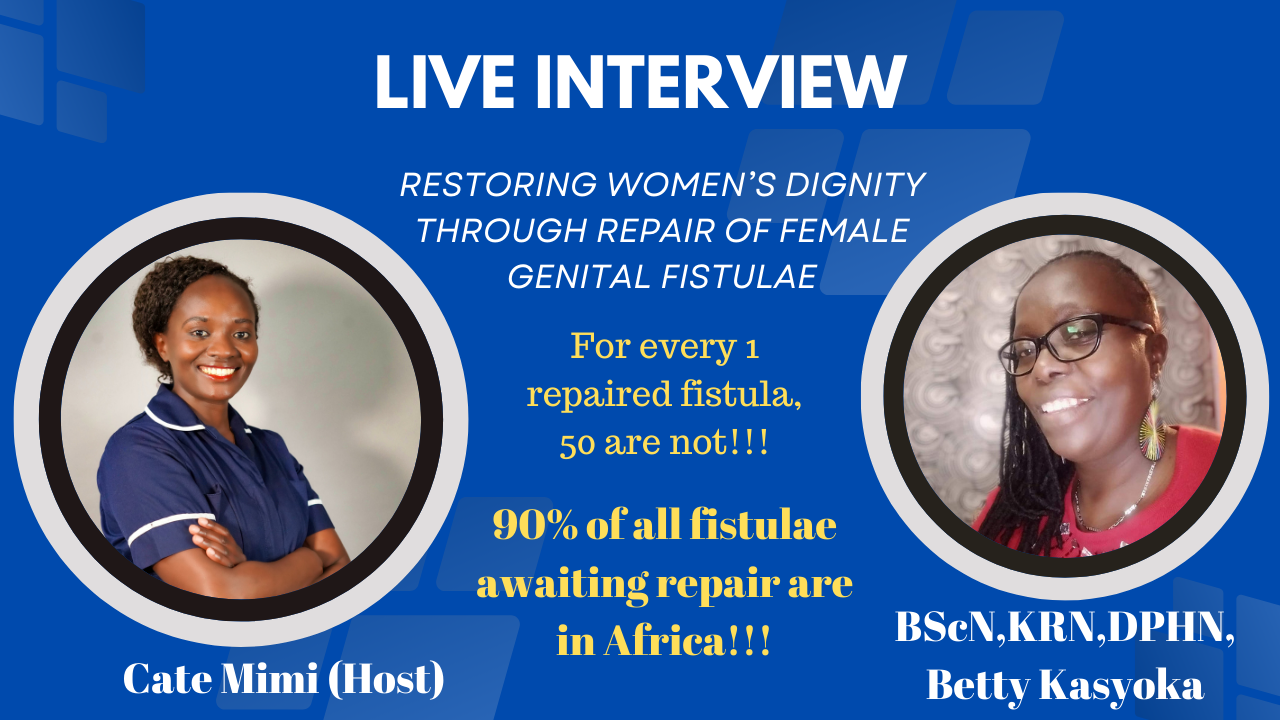
She is donned in a Maasai regalia complete with those dazzling beads worn on the forehead, Her dreadlocked hair completes her African theme for the day. She makes a joke or two about the internet and how she has kept all gadgets on the ready for the interview. I am not surprised. This is a nurse. Nurses come prepared. Her name is Betty Kasyoka, the current lead of nursing services in Thika Sub-county and the former Director of Nursing Services in Kiambu County in Kenya. Betty is a champion on a mission to ensure that all female genital fistulae in Kenya are repaired, free of charge.
The term fistula (plural fistulae) refers to an abnormal connection between two organs. It could be between a body cavity and another body cavity or a body organ and the skin. Female genital fistulae are connections between the birth canal (vagina) and the rectum or the birth canal and the urinary bladder. These abnormal connections are dehumanising to women causing many to be ostracized by their families, friends, and communities in general as well as leading to miserable lives in the lives of the affected women.
A couple of years ago while she was the Nursing Services Manager at Gatundu Level 5 Hospital, a public hospital in Kenya, Betty helped organize a medical camp for female genital fistulae repair and three hundred women turned up from every corner of Kenya. with the vital help of non-governmental organizations, these women had free repair of female genital fistulae. Betty was so shocked by the sheer number of patients that she saw it as a Godsent mission to reach out to women in society suffering in silence and help them access the dignity-restoring surgery.
The World Health Organization estimates that about 100,000 female genital fistulae are recorded every year with Africa recording close to 150,000 yearly. This data is highly skewed due to underreporting in Africa due to missed diagnoses. Not every clinician is skilled at examining and diagnosing a female genital fistula!
Betty explains that several factors cause female genital fistulae including weakened pelvic bones that could be a result of a contracted pelvis, prolonged, obstructed labor, scars in the female reproductive system, female genital mutilation, cancers of the reproductive and gastrointestinal systems, surgeries, and accidents that injure the pelvic area. There are two types of fistula commonly reported.
Types of Fistula
Urine Fistula
Betty calls this the most disturbing of the two main female genital fistulae. It happens when there is a tear between the bladder and the vaginal wall. During labor, the bony fetal head (head of the baby) presses onto the bladder and the rectum denying these organs of vital blood supply. The blood supply contains food for the cells and oxygen. If other factors are involved, then the cells lining the bladder and the vagina will start dying off and within two weeks, drop and leave a hole.
This hole leaks urine 24/7 from the bladder to the vagina. Betty explained that the fact that urine forms all the time, then it means that these women will always be smelling of urine making them not only an aversion to their spouses but to themselves. Some urine fistulae will be obvious after childbirth while others take time to be discovered.
Anal Fistula
This is an abnormal connection between the vagina and the rectum or anus. It occurs in the same way as the urine fistula only that this time, a hole is between the rectum and the vagina causing stool to pass into the vagina.
Some women have such tiny holes that they may never suspect that they have a fistula. The only things they report are farting through the vagina (usually when they stand up), their male sexual partners may see stool during sex on their penis, or even the women finding stool on the tissue paper after a short call.
This fistula is intermittent and therefore gets missed easily. If you have experienced the above symptoms, it is time to give Betty a call. Watch this video to find her details.
Conclusion
Perhaps the most important message of this post is the anatomical location of the vagina. This is key to understanding why the two fistulae are related. See, the vagina is hidden between two important tracts. One is the urinary as we have seen above and the other is the rectum and anus. During labor, a baby's head is expected to pass between those two tracts and obviously, it will press on everything else at the front (urinary bladder) and the back (rectum and anus).
The female genital fistulae are reparable and Betty helps women access these life-changing surgeries for free. This is in partnership with various foundations that fund this initiative. Moving ahead, Betty is available to train every clinician on how to examine for and suspect a female genital fistula. I hope you and I remain vigilant and intentional in the awareness of female genital fistulae in Kenya and abroad.
